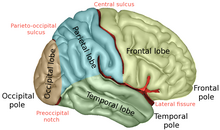Gourmand syndrome
| Gourmand syndrome | |
|---|---|
 | |
| Frontal lobe (at right) | |
| Specialty | Neurology |
Gourmand syndrome is a very rare and benign eating disorder that usually occurs six to twelve months after an injury to the frontal lobe.[1][2][3][4] Those with the disorder usually have a right hemisphere frontal or temporal brain lesion typically affecting the cortical areas, basal ganglia or limbic structures.[3][2][5][6] These people develop a new, post-injury passion for gourmet food.[3][2][5][4]
There are two main aspects of gourmand syndrome: first, the fine dining habits and changes to taste, and second, the obsessive component, which may result in craving and preservation.[2] Gourmand syndrome can be related to, and shares biological features with, addictive and obsessive disorders.[2][3] The syndrome was first characterised in 1997.[3]
Signs and symptoms[edit]
A new-found obsession for refined foods after frontal lobe injury is the primary characterization of Gourmand syndrome.[2][1][3][4][5][6][excessive citations]
Causes[edit]
It is believed that the frontotemporal circuits, normally involved in healthy eating, can, when injured, cause gourmand syndrome in patients.[4]
History[edit]
Only 36 people had been diagnosed with gourmand syndrome as of 2001.[6] In many of these cases, the patient did not have any interest in food beforehand nor had any family history with eating disorders.[5][2][3]
The first, most famous case was seen in 1997 by Regard and Landis in the journal Neurology:[2][3] after a Swiss stroke patient was released from the hospital, he immediately quit his job as a political journalist and took up the profession of food critic.[3] Regard and Landis also observed an athletic businessman with this condition whose family was shocked to see such a sudden, drastic change in his diet.[3]
Only one case of gourmand syndrome has been reported in a child. He was born with issues with his right temporal lobe; at eight years old he began to experience seizures, within the year of the seizures beginning, his behavior began to change to the symptoms of gourmand syndrome.[2]
In 2014, a man that was once interested in marathon running now was only interested in gastronomy, traveling hundreds or thousands of miles to eat gourmet food. He became a famous gastronomic critic and gained 50 kg (110 pounds).[5]
References[edit]
- ^ a b Pascual-Leone, Alvaro; Alonso-Alonso, Miguel (2007-04-25). "The Right Brain Hypothesis for Obesity". JAMA. 297 (16): 1819–1822. doi:10.1001/jama.297.16.1819. ISSN 0098-7484. PMID 17456824.
- ^ a b c d e f g h i Kurian, M.; Schmitt-Mechelke, T.; Korff, C.; Delavelle, J.; Landis, T.; Seeck, M. (2008). ""Gourmand syndrome" in a child with pharmacoresistant epilepsy". Epilepsy & Behavior. 13 (2): 413–415. doi:10.1016/j.yebeh.2008.04.004. PMID 18502182. S2CID 29040664.
- ^ a b c d e f g h i j Regard, Marianne; Landis, Theodor (1997). ""Gourmand syndrome": Eating passion associated with right anterior lesions". Neurology. 48 (5): 1185–1190. doi:10.1212/WNL.48.5.1185. PMID 9153440. S2CID 19234711.
- ^ a b c d Uher, R.; Treasure, J. (2004). "Brain lesions and eating disorders". J Neurol Neurosurg Psychiatry. 76 (6): 852–857. doi:10.1136/jnnp.2004.048819. PMC 1739667. PMID 15897510.
- ^ a b c d e Gallo, M.; Gámiz, F.; Perez-Garíca, M.; Morals, R.; Rolls, T. (2014). "Taste and olfactory status in a gourmand with a right amygdala lesion". Neurocase. 20 (4): 421–433. doi:10.1080/13554794.2013.791862. hdl:10481/86875. PMID 23668221. S2CID 13334347.
- ^ a b c Cummings, Jeffery L.; Lichter, David G. (2001). Frontal-Subcortical Circuits in Psychiatric and Neurological Disorders. New York, London: Guliford Press. pp. 167–169. ISBN 1-57230-623-8.
Further reading[edit]
- Uher, R (2005). "Brain lesions and eating disorders". Journal of Neurology, Neurosurgery & Psychiatry. 76 (6): 852–7. doi:10.1136/jnnp.2004.048819. PMC 1739667. PMID 15897510.
- Bramen, Lisa (2011-07-06). "Gourmand Syndrome – First identified by neuroscientists in the 1990s, the disorder is marked by "a preoccupation with food and a preference for fine eating". Smithsonian.com. Retrieved 27 April 2015.
